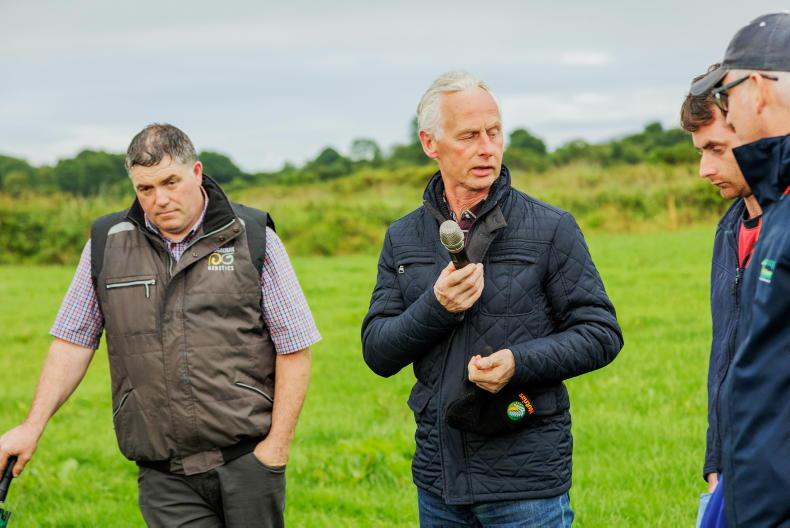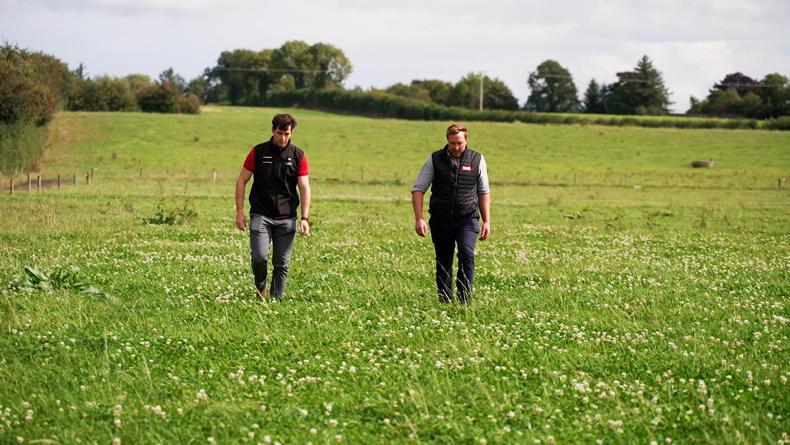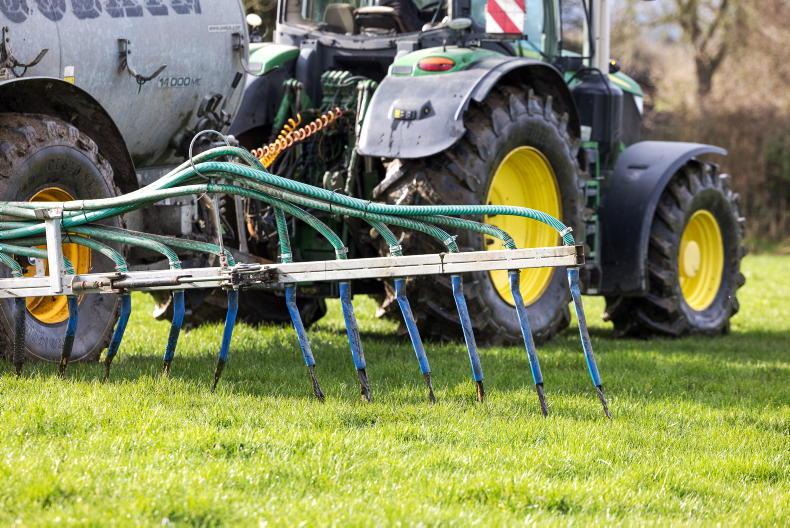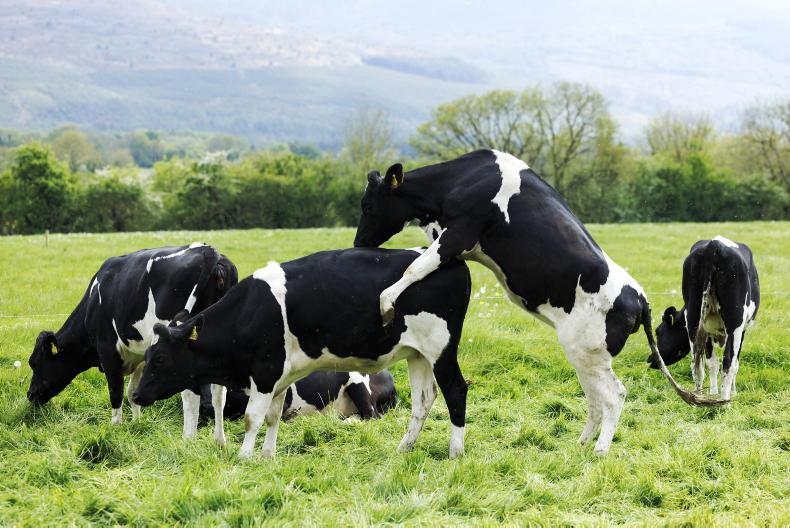After the abolition of quota, many dairy farmers sought to move replacement heifers off-farm to maximise the number of cows they could keep, thereby maximising production.
This worked well for drystock farmers, who were seeking additional means of farm income, with replacement rearing providing a fixed, regular income.
It also allowed farmers to increase their stocking rate without having to seek stocking loans, and provided some farmers with a lighter stock type that could be turned out to grass early and kept out late.
Kieran Henry
Teagasc recently held a walk on the farm of Kieran Henry, in Tubbercurry, Co Sligo. When additional land came up for lease, Kieran and his wife chose to lease it. However, upon applying to their bank for loans to secure additional stock and improve facilities, the feasibility of increasing drystock numbers was questioned, so Kieran looked at alternative measures.

Kieran Henry (left) and dairy farmer Joseph Dunphy explained the need for trust between the two parties when entering a contract.
He now rears 60 dairy heifers alongside his pedigree Limousin herd and a batch of dairy bull calves reared for Teagasc. Eighteen hectares are devoted to the heifer rearing. Having originally reared smaller groups for different farmers, Kieran is now rearing 60 heifers per annum for the Dunphy family from Easkey, Co Sligo. Heifers arrive as weanlings each November, with Kieran bringing them through to the following year when they return as in-calf heifers to the Dunphys and are replaced with another batch of maiden heifers. There are a number of alternatives to this, with some dairy heifers arriving on farms at 10 days old or as weanlings at 12 weeks of age.
Additional revenue stream
Tom Coll, a Teagasc adviser based in Mohill, Co Leitrim, explained to the crowd that Teagasc was not promoting contract rearing to push suckler beef out, but as a suitable additional revenue stream alongside existing drystock enterprises.
A fixed monthly income allows farmers to have an improved cashflow. It also allows them to not have to continually finance the purchase of cattle through stocking loans.
Coll, the facilitator for a local contract heifer rearing discussion group, said there has been a renewed interest from drystock and dairy farmers in contract rearing, with drystock farmers seeking a fixed income in light of recent inflation and dairy farmers seeking to reduce stocking rates due to increased costs, difficulty in renting land and an increased pressure on nitrates and stocking rates.
While most heifer contracts would be for two to five years, dairy adviser Cian Devaney explained that flexibility is required from both sides. A return date for heifers to go back to the dairy farm should be a window of two to three weeks rather than a fixed date.
Costs were one of the main topics of the walk, with flexibility needed surrounding this year’s increased input costs for the drystock farmers.
Teagasc has reviewed costs for 2022, which are tabled in the chart, based on bringing a 12-week-old heifer calf through to the following winter.
A win/win for
both farmers
Coll highlighted that for contract heifer rearing to be successful, it has to be a win-win for both the dairy and dystock farmers. Dairy farmers have to receive heifers back with a high percentage of them incalf and on target for weight, while drystock farmers need to be rewarded financially for their work.
Michael and Joseph Dunphy, the suppliers of the heifers to Kieran, also spoke of the trust that each farmer must put in the other. ‘’I believed that nobody could rear our heifers better than we could before now’’ said Joseph. ‘’But when the first batch of heifers came back from Kieran, I knew he had done a better job on them than we ever could’’.
Releasing heifers to drystock farmers also allows dairy farmers simplify their system, having fewer groups of stock to manage. The extra time they can gain from contracting out heifer rearing can be invested in better grassland management, improving farm key performance indicators or simply taking more time away from the farm.
After the abolition of quota, many dairy farmers sought to move replacement heifers off-farm to maximise the number of cows they could keep, thereby maximising production.
This worked well for drystock farmers, who were seeking additional means of farm income, with replacement rearing providing a fixed, regular income.
It also allowed farmers to increase their stocking rate without having to seek stocking loans, and provided some farmers with a lighter stock type that could be turned out to grass early and kept out late.
Kieran Henry
Teagasc recently held a walk on the farm of Kieran Henry, in Tubbercurry, Co Sligo. When additional land came up for lease, Kieran and his wife chose to lease it. However, upon applying to their bank for loans to secure additional stock and improve facilities, the feasibility of increasing drystock numbers was questioned, so Kieran looked at alternative measures.

Kieran Henry (left) and dairy farmer Joseph Dunphy explained the need for trust between the two parties when entering a contract.
He now rears 60 dairy heifers alongside his pedigree Limousin herd and a batch of dairy bull calves reared for Teagasc. Eighteen hectares are devoted to the heifer rearing. Having originally reared smaller groups for different farmers, Kieran is now rearing 60 heifers per annum for the Dunphy family from Easkey, Co Sligo. Heifers arrive as weanlings each November, with Kieran bringing them through to the following year when they return as in-calf heifers to the Dunphys and are replaced with another batch of maiden heifers. There are a number of alternatives to this, with some dairy heifers arriving on farms at 10 days old or as weanlings at 12 weeks of age.
Additional revenue stream
Tom Coll, a Teagasc adviser based in Mohill, Co Leitrim, explained to the crowd that Teagasc was not promoting contract rearing to push suckler beef out, but as a suitable additional revenue stream alongside existing drystock enterprises.
A fixed monthly income allows farmers to have an improved cashflow. It also allows them to not have to continually finance the purchase of cattle through stocking loans.
Coll, the facilitator for a local contract heifer rearing discussion group, said there has been a renewed interest from drystock and dairy farmers in contract rearing, with drystock farmers seeking a fixed income in light of recent inflation and dairy farmers seeking to reduce stocking rates due to increased costs, difficulty in renting land and an increased pressure on nitrates and stocking rates.
While most heifer contracts would be for two to five years, dairy adviser Cian Devaney explained that flexibility is required from both sides. A return date for heifers to go back to the dairy farm should be a window of two to three weeks rather than a fixed date.
Costs were one of the main topics of the walk, with flexibility needed surrounding this year’s increased input costs for the drystock farmers.
Teagasc has reviewed costs for 2022, which are tabled in the chart, based on bringing a 12-week-old heifer calf through to the following winter.
A win/win for
both farmers
Coll highlighted that for contract heifer rearing to be successful, it has to be a win-win for both the dairy and dystock farmers. Dairy farmers have to receive heifers back with a high percentage of them incalf and on target for weight, while drystock farmers need to be rewarded financially for their work.
Michael and Joseph Dunphy, the suppliers of the heifers to Kieran, also spoke of the trust that each farmer must put in the other. ‘’I believed that nobody could rear our heifers better than we could before now’’ said Joseph. ‘’But when the first batch of heifers came back from Kieran, I knew he had done a better job on them than we ever could’’.
Releasing heifers to drystock farmers also allows dairy farmers simplify their system, having fewer groups of stock to manage. The extra time they can gain from contracting out heifer rearing can be invested in better grassland management, improving farm key performance indicators or simply taking more time away from the farm.











SHARING OPTIONS